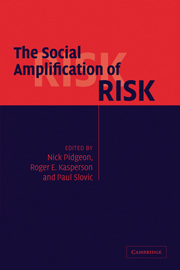Book contents
- Frontmatter
- Contents
- List of figures
- List of tables
- List of contributors
- Acknowledgments
- Introduction
- Part I Conceptual foundations
- Part II Risk signals and the mass media
- Part III Public perceptions and social controversy
- Part IV Risk ripples and stigma effects
- Part V Policy and management
- 15 Searching for the public policy relevance of the risk amplification framework
- 16 Social amplification of risk in participation: two case studies
- Bibliography
- Index
16 - Social amplification of risk in participation: two case studies
Published online by Cambridge University Press: 06 July 2010
- Frontmatter
- Contents
- List of figures
- List of tables
- List of contributors
- Acknowledgments
- Introduction
- Part I Conceptual foundations
- Part II Risk signals and the mass media
- Part III Public perceptions and social controversy
- Part IV Risk ripples and stigma effects
- Part V Policy and management
- 15 Searching for the public policy relevance of the risk amplification framework
- 16 Social amplification of risk in participation: two case studies
- Bibliography
- Index
Summary
Inviting the public to be part of the decision making process in risk analysis and management has been a major objective in European and American risk policy arenas. The recent report by the National Academy of Sciences encourages risk professionals to foster citizen participation and public involvement in risk management (Stern and Fineberg 1996). The report emphasizes the need for a combination of assessment and dialogue which the authors have framed the “analytic-deliberative” approach. Unfortunately, early involvement of the public in deliberative processes may compromise, however, the objective of efficient and effective risk reduction or violate the principle of fairness (Okrent 1996).
The popularity associated with the concepts of two-way communication, trust-building, and citizen participation, however, obscures the challenge of how to put these noble goals into practice and how to ensure that risk management reflects competence, efficiency, and fair burden sharing. One of the major challenges in participation is the problem of putting risks in perspective. Experts and governmental regulatory bodies manage hazards based on numerical assessments of their potential risks, denned as magnitude times probability of a hazard event occurring (expected value). To the risk professionals, it has been hard to accept that the public judges the seriousness of risk according to a different set of characteristics and, as a consequence, places different priorities on where to reduce or manage risks first. Juxtaposing professional estimates of risks and public perceptions of risk has been a popular activity among risk researchers ever since the United States Environmental Protection Agency (EPA) published its Unfinished Business report (United States EPA 1987).
- Type
- Chapter
- Information
- The Social Amplification of Risk , pp. 374 - 401Publisher: Cambridge University PressPrint publication year: 2003
- 23
- Cited by



